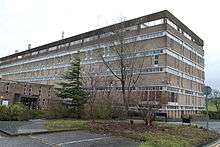University of Edinburgh School of Physics and Astronomy
The University of Edinburgh School of Physics and Astronomy is the physics department of the University of Edinburgh. The school was formed in 1993 by a merger of the Department of Physics - called the Department of Natural Philosophy until the late 1960s - and the Department of Astronomy, both at the University of Edinburgh. The school is part of the University's College of Science and Engineering.[1][2]
 | |
| Affiliation | EPCC, Institute of Physics |
|---|---|
| Campus | James Clerk Maxwell Building, King's Buildings, Edinburgh, Scotland |
| Website | www |
Institutes
Institutions and research groups based within the school include:
- Institute for Astronomy (IfA) - One of the UK's major centres of astronomical research, specialising in survey astronomy, cosmology, active galaxies and the formation of stars and planets.
- Institute for Condensed Matter and Complex Systems (ICMCS)
- Institute for Particle and Nuclear Physics (IPNP)
- EPCC - One of the leading supercomputing centres in Europe, home to the UK's national supercomputing service, HECToR.
- Higgs Centre for Theoretical Physics - A new centre established in 2012 to "seek an even deeper understanding of how the universe works."[3]
The school is housed in the James Clerk Maxwell Building on the University's King's Buildings campus.
Notable people
Notable physicists associated with the University have included Joseph Black, Max Born, Peter Higgs, James Clerk Maxwell and Peter Guthrie Tait. Five winners of the Nobel Prize in Physics are associated with the University (Edward Victor Appleton, Charles Glover Barkla, Max Born, Igor Tamm and Peter Higgs).
See also
External links
References
- "About the School of Physics and Astronomy". University of Edinburgh. Retrieved 1 August 2012.
- "Physics Quality Profiles, Research Assessment Exercise 2008". Retrieved 1 August 2012.
- "University to support new physics research". University of Edinburgh. Retrieved 4 August 2012.
.jpg)